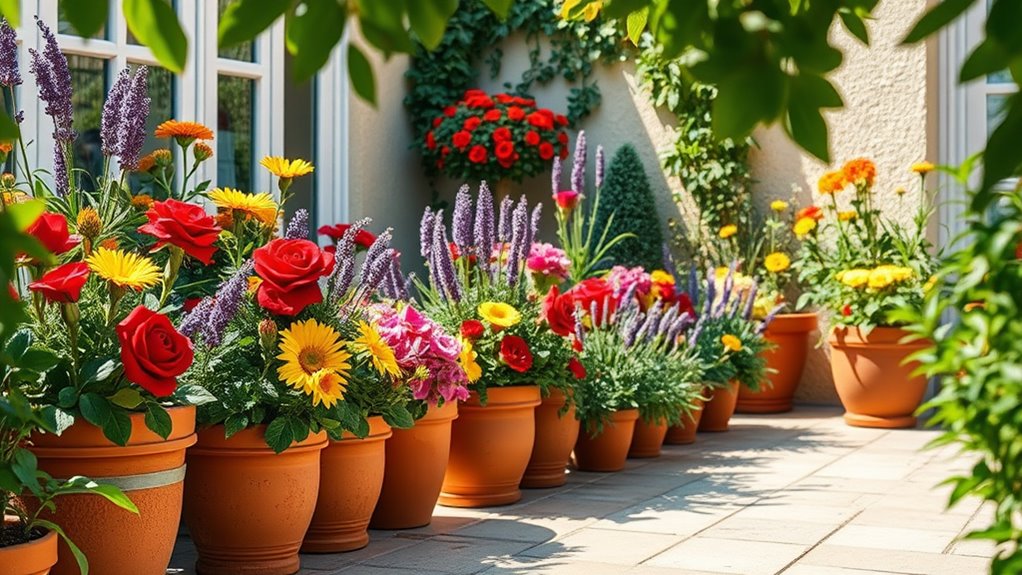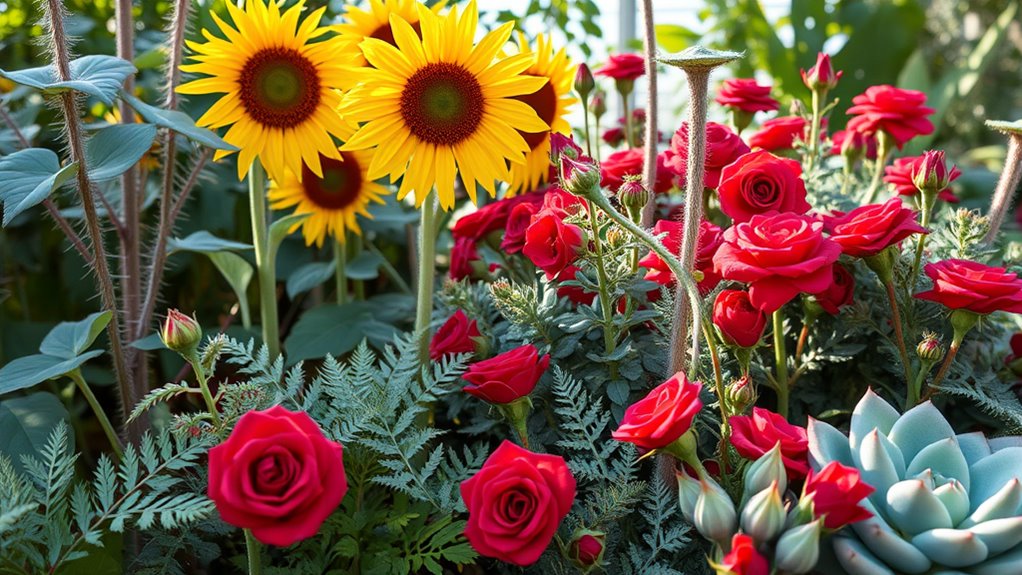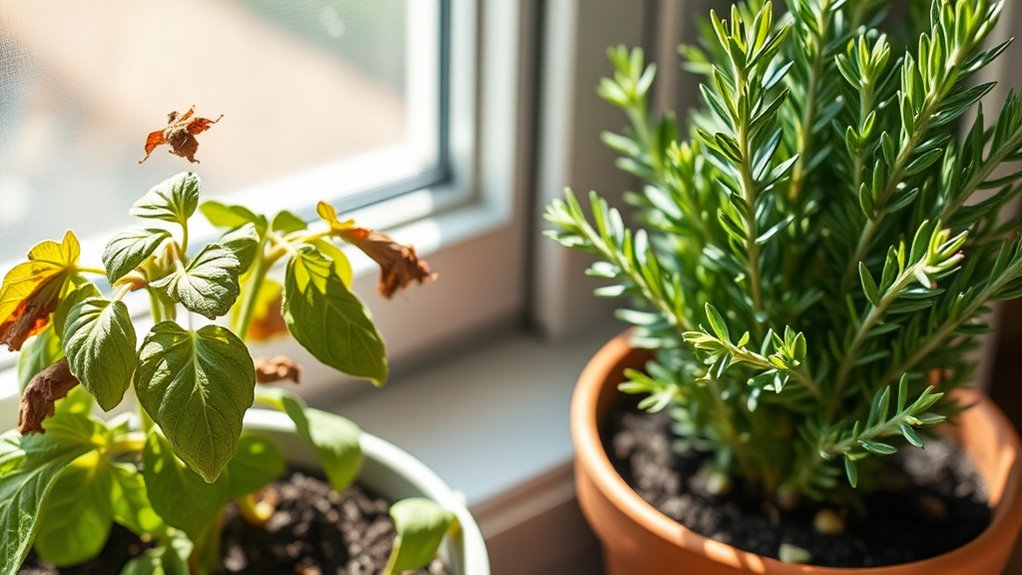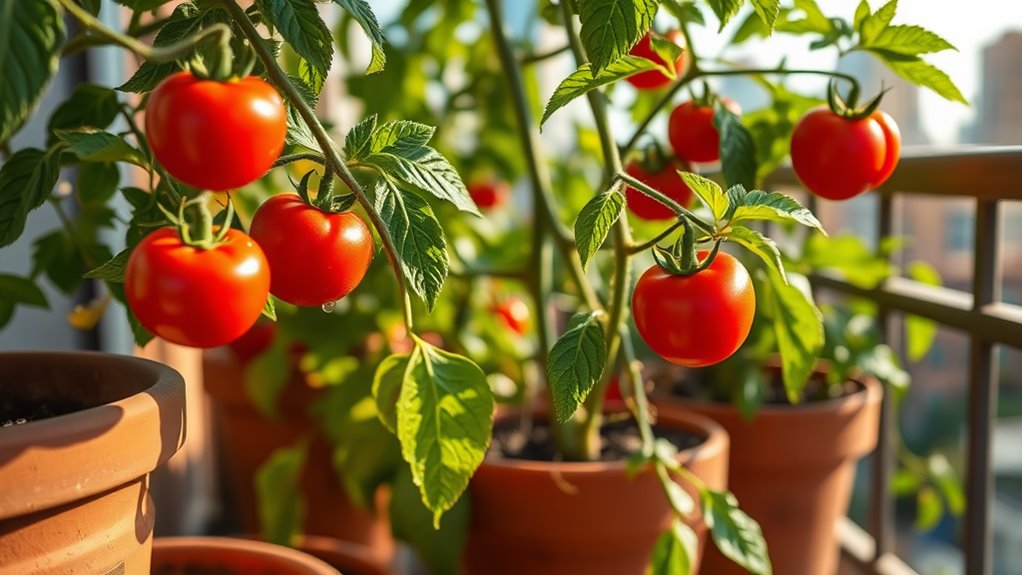How I Turned My Patio Into a Flower Paradise With Just a Few Steps
Transform your patio into a vibrant flower paradise by first assessing sunlight, soil, and space for an optimal layout. Choose sun-loving or shade-tolerant flowers that fit your conditions, then prepare the soil with compost for better drainage. Plant them with proper spacing, water regularly, and fertilize to keep blooms thriving while handling pests early. You’ll soon enjoy a colorful oasis, and uncover additional techniques to elevate your garden even more.
Key Takeaways
- Assess your patio’s sunlight, soil, and space to design a vibrant, efficient layout.
- Choose sun-loving flowers and amend soil with compost for optimal growth and drainage.
- Plant flowers in prepared soil, ensuring proper spacing and depth for healthy roots.
- Water and fertilize regularly, while deadheading blooms to maintain vitality.
- Monitor for pests, use companion planting, and add vertical elements to expand your paradise.
Assessing Your Patio Space
Before you transform your patio into a flower paradise, assess your space to ensure it supports healthy growth.
In flower gardening tips, first evaluate sunlight exposure; most flowers thrive with six to eight hours daily, so track patterns throughout the day.
Next, test soil quality and drainage—dig a small hole to check if water pools, indicating poor runoff that could harm roots.
Measure available space for containers or beds, ensuring good airflow to prevent disease. Moreover, planning garden layout is essential for arranging plants to maximize space and promote healthy growth.
Also, consider microclimates like shaded spots or wind-prone areas to optimize your layout for vibrant results.
When planning your flower garden, also consider choosing plants that are suitable for your specific conditions, adapting from foundational gardening advice.
Choosing the Perfect Flowers
Now that you’ve assessed your patio space, you’ll select flowers that thrive in its unique conditions.
Start by evaluating sunlight: opt for sun-loving blooms like zinnias or marigolds in bright spots, or shade-tolerant impatiens in dimmer areas.
Consider water needs too—drought-resistant options like lavender suit dry spots, while hydrangeas prefer moisture.
Factor in space; compact varieties fit small patios, while climbers add vertical interest.
Always check hardiness zones to ensure year-round success, and pick a mix for color and pollinators.
This targeted approach creates a vibrant, low-maintenance paradise tailored to you. Additionally, explore perfect plant pairs to enhance growth and create a more resilient garden ecosystem.
Furthermore, to create a butterfly haven, incorporate flowers known to attract butterflies for a thriving, pollinator-friendly environment.
Preparing the Soil for Planting
Before you plant your patio flowers, you’ll want to test your soil’s pH to match it with your chosen plants’ needs.
Once you’ve checked the pH, amend the soil by mixing in compost to boost nutrients and drainage.
This simple preparation ensures your flowers thrive in a healthy environment.
By prioritizing soil testing, you can enhance plant health and promote better overall growth.
For optimal garden success, consider conducting a soil testing to identify and address any potential nutrient deficiencies or imbalances.
Test Soil Ph
Testing your soil’s pH is a key step in preparing the perfect bed for your patio flowers. This simple test reveals whether your soil is acidic, neutral, or alkaline, directly affecting nutrient availability for plants.
You’ll need an inexpensive pH test kit from a garden store; it’s easy to use. Take samples from several spots on your patio, mix with distilled water as directed, and apply the testing solution.
Most flowers prefer a pH of 6.0 to 7.0—if yours falls outside this range, you’ll identify imbalances early, ensuring healthier blooms without guesswork. Track results for reference.
Amend With Compost
Compost boosts your soil’s fertility and structure, turning it into a nutrient-rich base for your patio flowers.
Once you’ve tested pH, select high-quality compost to balance nutrients. Spread a 2-3 inch layer evenly across your beds, then use a garden fork to work it in deeply—aim for the top 6-8 inches of soil.
This enhances aeration, water retention, and microbial activity, preventing compaction. You’ll foster robust root growth and disease resistance.
Monitor moisture levels post-amendment; water lightly if needed. For practicality, mix in compost annually to maintain vitality and ensure thriving blooms year-round.
Designing a Vibrant Layout
You can kick off your vibrant layout by choosing plants that burst with color and suit your patio’s light and soil. This blog post provides plant recommendations that can guide your selections to create a more diverse and resilient garden.
Next, plan the arrangement to optimize space, ensuring taller blooms frame shorter ones for a dynamic flow.
Don’t forget to balance color elements, mixing bold hues with neutrals for a polished, inviting paradise.
Additionally, incorporate maintenance tips to ensure your flower bed remains healthy and vibrant over time.
Choose Vibrant Plants
When designing a vibrant layout for your patio, start by selecting plants that offer bold colors and varied textures to create an eye-catching display.
You’ll want to focus on perennials like coneflowers for their long-lasting blooms and vibrant hues, or annuals such as marigolds for pops of orange and yellow.
Consider your patio’s sunlight; opt for sun-loving plants like zinnias if it’s exposed, or shade-tolerant impatiens for cooler spots.
Always check hardiness zones to ensure they’re suitable for your climate, and choose low-maintenance varieties to keep your garden thriving without overwhelming effort.
This selection sets a strong foundation.
Plan Layout Arrangement
After selecting your vibrant plants, arrange them strategically to maximize visual appeal and functionality on your patio.
Begin with a simple sketch to map out your space, considering its dimensions and key features. Position taller plants at the back for depth and layers, while placing shorter ones along edges or pathways for definition.
Create groupings to draw the eye and foster a sense of flow, ensuring easy access for maintenance. Factor in environmental elements like sunlight and wind to protect plants.
Experiment with symmetry for formality or asymmetry for a natural look, then adjust as needed for optimal growth and usability.
Balance Color Elements
Balancing colors in your patio layout transforms a simple arrangement into a captivating focal point.
Start by assessing your space’s light and size to select harmonious hues. Use the color wheel to pair complementary shades, like vibrant reds with soft greens, for eye-catching contrast without overwhelming the eye.
Incorporate a 60-30-10 rule: dominate with one color, support with a secondary, and accent with pops for depth.
Mix flower heights and textures to layer visuals, and rotate seasonal blooms to maintain balance.
Test your design first; you’ll create a vibrant, practical paradise that evolves beautifully.
Planting Your Flowers Step by Step
Once you’ve gathered your flowers and tools, planting them step by step transforms your patio into a vibrant haven. This process ensures healthy growth and maximizes visual appeal.
You’ll need to focus on proper technique to avoid common pitfalls like root damage.
To plant effectively, follow these four key steps:
-
Prepare the soil: Loosen it to 6-8 inches deep, removing weeds and amending with compost for better drainage and nutrients.
-
Dig appropriate holes: Make them twice the root ball’s width and depth, spacing plants according to their mature size.
-
Position and plant: Place each flower at the correct depth, backfill with soil, and gently firm around the base to eliminate air pockets.
-
Mulch lightly: Add a thin layer to retain moisture and suppress weeds, but don’t overdo it.
After planting, ensure to provide ongoing care to support vibrant blooms throughout the season.
Additionally, for plants to thrive in various environmental conditions, incorporate universal soil prep methods into your routine.
Watering and Fertilizing Essentials
While your flowers take root, you’ll quickly discover that effective watering and fertilizing are key to their thriving. In extreme heat, applying heat-proof watering techniques can help ensure your plants stay hydrated and healthy.
Water early in the morning or late evening to minimize evaporation, ensuring the soil stays moist but not soggy—aim for about an inch of water per week, adjusted for weather. Test soil moisture with your finger; if it’s dry an inch deep, it’s time to water.
For fertilizing, choose a balanced, slow-release formula and apply every four to six weeks during the growing season. Mix it into the soil around your plants to promote steady nutrient uptake, boosting vibrant growth without overwhelming roots.
Always follow package instructions for the best results.
To enhance your gardening success, consider expert watering techniques to avoid common pitfalls like overwatering.
Maintaining Healthy Blooms
As your flowers flourish from proper watering and fertilizing, you must focus on maintaining healthy blooms to extend their vibrant display. This involves regular monitoring to catch issues early and keep plants strong.
Effective maintenance includes:
- Deadhead spent blooms weekly to encourage new growth and prevent seed production.
- Prune dead or diseased stems promptly to improve air circulation and reduce disease risk.
- Inspect for pests like aphids regularly and treat with organic solutions to protect foliage.
- Mulch around bases to retain soil moisture and suppress weeds, supporting overall health.
Adding Decorative Touches
To enhance your patio’s appeal, incorporate decorative elements that complement your thriving blooms.
You’ll add string lights for enchanting evening ambiance, or position weatherproof planters and trellises to frame your flowers artfully.
Choose garden statues or wind chimes that echo your space’s style, ensuring they harmonize with colors and textures.
Select durable, low-maintenance materials like wrought iron or resin to withstand outdoor conditions.
Arrange seating with colorful cushions for relaxation, turning your patio into a cohesive, inviting haven.
These practical additions elevate aesthetics without overwhelming your floral display.
Handling Pests and Diseases
As you tend your patio flowers, start by identifying pests early to spot threats like aphids or mites before they damage your plants.
Then, take immediate action to control diseases such as fungal spots by removing affected areas and applying targeted treatments.
Finally, implement preventive measures like regular inspections and proper watering to keep your garden thriving and pest-free.
Identifying Pests
How can you quickly spot pests on your patio flowers? Start by inspecting plants regularly for early signs. You’ll catch issues before they escalate, keeping your garden thriving.
-
Check for damage: Look for holes, chewed leaves, or wilting, which indicate hungry insects like aphids or caterpillars.
-
Examine closely: Flip leaves to spot tiny pests such as mites or scale, often hiding underneath.
-
Watch for residue: Sticky honeydew or webbing signals sap-suckers and spiders.
-
Monitor plant health: Yellowing, stunted growth, or distorted blooms can point to hidden infestations.
Act promptly on these clues to protect your floral haven.
Controlling Diseases
While pests might threaten your patio flowers, diseases like fungal infections or bacterial wilts demand swift action to keep them in check.
You identify symptoms early, such as spots or wilting, then prune affected areas immediately to halt spread. Apply targeted fungicides or bactericides as directed, ensuring full coverage without harming beneficial insects.
Isolate sick plants to protect others, and dispose of debris properly. Regularly inspect your blooms for changes, and if issues persist, consult a local expert for precise diagnosis.
This proactive control maintains your paradise’s vibrancy and health.
Preventive Measures
To prevent pests and diseases from undermining your patio flowers, you’ll want to focus on proactive strategies that build plant resilience.
Start by selecting disease-resistant varieties and maintaining optimal growing conditions. Regular monitoring helps catch issues early, while natural defenses keep your garden thriving.
Here are four key preventive steps:
- Choose resistant plants: Opt for hybrids that naturally ward off common pests and diseases.
- Improve soil health: Amend with organic matter to boost nutrient uptake and microbial balance.
- Practice good hygiene****: Remove dead foliage and weeds to eliminate hiding spots for pests.
- Apply natural barriers: Use companion planting or neem oil to deter invaders without chemicals.
Expanding and Enhancing Your Paradise
As your patio garden thrives, you’ll find expanding and enhancing it keeps your space vibrant and inviting.
Start by adding vertical elements like trellises or hanging baskets to maximize space and introduce new flower varieties for color diversity. Incorporate companion planting to boost soil health and deter pests naturally.
Upgrade with practical features, such as automated watering systems or mulch, to maintain moisture and reduce weeds. Experiment with seasonal blooms to ensure year-round appeal, and regularly prune to promote growth.
Track your garden’s progress to make informed adjustments, creating a personalized, flourishing oasis.





